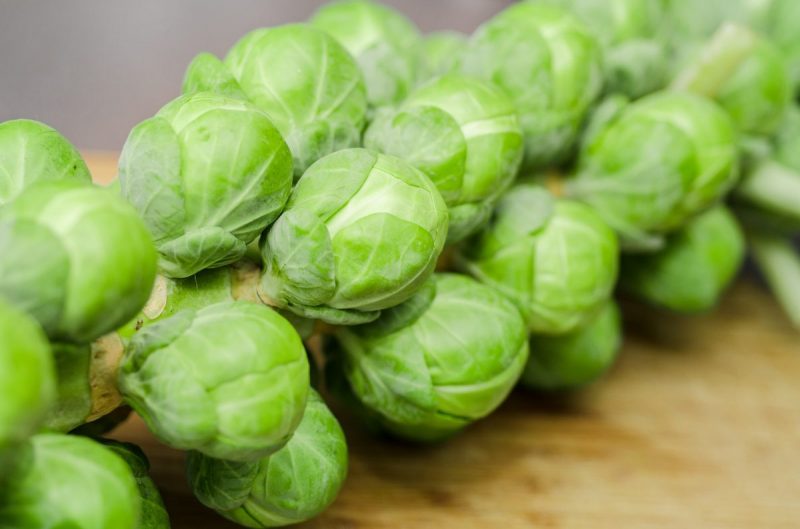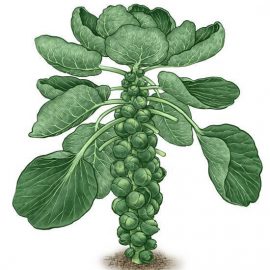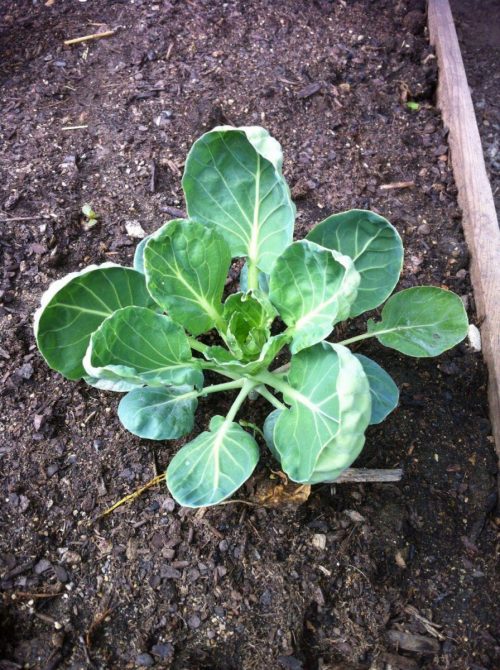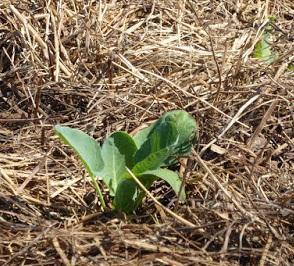Brussels sprouts, information about crop management

Brussels sprouts (Brassica oleracea var. gemmifera) are grown for the sprouts that form at the base of the leaves and are consumed in various forms during the autumn-winter period. The plants are resistant to low temperatures and in areas with mild winters, the plants can remain in the field until spring. The Brussels sprouts have a pleasant taste and contain significant amounts of vitamins and minerals. It also has therapeutic properties.
The plant is native to the Mediterranean Sea and the Atlantic Ocean and was introduced into the culture in the 18th century. It quickly became very popular and cultivation spread to Great Britain, Belgium, Holland, and France. The highest consumption of Brussels sprouts is in the UK, the Netherlands, and Belgium.
It is a biennial plant with a well-developed root system. The stem is tall, 0.8-1.2 m, with petiolate, cordate leaves. On the stem, 40-70 buds will form, from which the greenish sprouts will develop. At consumption maturity, the sprouts will be 3-4 cm in diameter and as they develop, the leaves begin to fall off. In the second year of growth, flowering stems with yellow flowers will form out of the sprouts. One plant has between 3000 and 5000 flowers.
Climate and soil requirements
The optimum growing temperature is between 15 and 21℃ and the spouts develop normally at temperatures of 15-18℃, higher temperatures negatively influence their development. This species has high light requirements only in the seedling phase. Water requirements are high, with constant soil moisture needed for good growth and development. It is not recommended to alternate dry periods with excess water. Brussels sprouts prefer deep, fertile, and well-structured soils.
Cultivation
Soil preparation
In autumn, you can fertilize with well-decomposed manure, but Brussels sprouts also react well to chemical fertilizers. After the basic fertilization, the soil needs to be tilled to a depth of 25-30 cm. In spring the soil should be well tilled and optionally you can apply NPK complex fertilizer. A pre-emergent herbicide can be used before planting.
Recommended products
-
You can find products on a different store
Change Store -
You can find products on a different store
Change Store -
You can find products on a different store
Change Store -
You can find products on a different store
Change Store -
You can find products on a different store
Change Store -
You can find products on a different store
Change Store -
You can find products on a different store
Change Store -
You can find products on a different store
Change Store -
You can find products on a different store
Change Store -
You can find products on a different store
Change Store -
You can find products on a different store
Change Store -
You can find products on a different store
Change Store -
You can find products on a different store
Change Store -
You can find products on a different store
Change Store -
You can find products on a different store
Change Store -
You can find products on a different store
Change Store -
You can find products on a different store
Change Store -
You can find products on a different store
Change Store -
You can find products on a different store
Change Store -
You can find products on a different store
Change Store -
You can find products on a different store
Change Store -
You can find products on a different store
Change Store -
You can find products on a different store
Change Store -
You can find products on a different store
Change Store
Seedling preparation and planting
The Brussels sprout crop is established by seedlings, previously produced in seedbeds or seedling beds. It is recommended to use peat as a substrate for sowing and sprouting, as it is free from diseases and pests. Once 2-3 real leaves have formed, you can apply foliar fertilizers. For one hectare of crop, 200-250 grams of seed are needed.
Sowing should be done 4-6 weeks before planting in the field, about 2.5 cm between rows and 2.5 cm between plants per row. When the seedlings have 2 true leaves, they should be pricked out into pots 5 x 5 x 5 cm.
At planting, the seedlings should be 50-60 days old and 10-15 cm tall. The branches shall be planted so that the leaves on the lower part of the plant touch the ground. Planting distances are 70 cm between rows and 40 cm between plants per row.
Pest and disease control
It is done by applying specific fungicide and insecticide treatments. To avoid the appearance of diseases or pests resistant to pesticides, it is recommended to alternate products.
Weed control
To encourage gas exchange at the root level, the soil must be regularly loosened by hoeing. Herbicides can also be applied to control weeds.
Recommended products
-
You can find products on a different store
Change Store -
You can find products on a different store
Change Store -
You can find products on a different store
Change Store -
You can find products on a different store
Change Store -
You can find products on a different store
Change Store -
You can find products on a different store
Change Store -
You can find products on a different store
Change Store -
You can find products on a different store
Change Store -
You can find products on a different store
Change Store -
You can find products on a different store
Change Store -
You can find products on a different store
Change Store -
You can find products on a different store
Change Store -
You can find products on a different store
Change Store -
You can find products on a different store
Change Store -
You can find products on a different store
Change Store -
You can find products on a different store
Change Store -
You can find products on a different store
Change Store -
You can find products on a different store
Change Store -
You can find products on a different store
Change Store -
You can find products on a different store
Change Store -
You can find products on a different store
Change Store -
You can find products on a different store
Change Store -
You can find products on a different store
Change Store -
You can find products on a different store
Change Store
Other tips and care works
Four days after planting, fill the gaps in the crop with spare seedlings of the same variety/hybrid.
The soil can be mulched before planting with polythene sheeting or after planting if plant material such as straw is used. This will make the soil warmer, weeds will stop growing and the microbiological activity of the soil will be stimulated.
If there is no rainfall, irrigation is necessary throughout the growing season. Watering can be done in furrows, by sprinkling, or preferably by drip.
To obtain high yields, apply fertilizers. Fertilizers should be applied 3-4 weeks after planting, using complex fertilizers.
Recommended products
-
You can find products on a different store
Change Store -
You can find products on a different store
Change Store -
You can find products on a different store
Change Store -
You can find products on a different store
Change Store -
You can find products on a different store
Change Store -
You can find products on a different store
Change Store -
You can find products on a different store
Change Store -
You can find products on a different store
Change Store -
You can find products on a different store
Change Store -
You can find products on a different store
Change Store -
You can find products on a different store
Change Store -
You can find products on a different store
Change Store -
You can find products on a different store
Change Store -
You can find products on a different store
Change Store -
You can find products on a different store
Change Store -
You can find products on a different store
Change Store -
You can find products on a different store
Change Store -
You can find products on a different store
Change Store -
You can find products on a different store
Change Store -
You can find products on a different store
Change Store -
You can find products on a different store
Change Store -
You can find products on a different store
Change Store -
You can find products on a different store
Change Store -
You can find products on a different store
Change Store
When the sprouts are 1 cm in diameter, you can break off the top of the plant. This will make the sprouts mature faster and the yield will be of higher quality. If you want the plant to mature faster, break off the first 25 cm of the stem.
Harvesting
Brussels sprouts are harvested after frost when the sprouts are firm, compact, and deep green. The sprouts should be about 3-4 cm in diameter. The operation can be carried out from autumn to spring by cutting the stems, after which the sprouts are removed. They can be stored for up to 5 weeks in controlled-atmosphere warehouses at 0℃ and 95% humidity.


















































































































































































































































































































































































































































